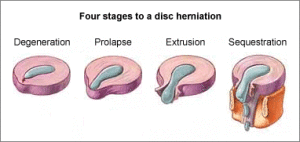A disc herniation or a “slipped disc” are both technically incorrect terms. Buckle up for a wild ride into the world of disc issues as we know it. A little caveat, we base disc “herniations” on an unweighted position since MRI’s are still done in a laying position. Eventually we are going to do them in a weight bearing position, but the limit is the technology hasn’t caught up yet.
- The first type of disc issue is a disc bulge/degeneration. This is when the disc “bulges” out across the entire posterior vertebral body. Meaning there is a large mass of disc bulge that protrudes out. This condition is sometimes considered “normal” amongst radiologist and may cause no pain, but then again may cause pain.
- A prolapse is when the wall of the disc has been compromised in some way. There may be a tear in the disc that is causing the “nuclear material” of the disc to push out through the disc wall. What the heck does that mean? That means there is a portion of your disc that is pushing out with the jelly like filling of the disc that is causing an impingement on your spinal cord or spinal nerve root. What the difference? Your spinal cord is the main truck that runs down your spine and the nerve roots are the little nerves that exit at each level. These nerves then travel to parts of your body. This is what causes arm pain, numbness, tingling and the same in your legs.
- A disc extrusion is when the disc has pushed through the wall of the disc enough to cause a greater compromise on the nerve. This is a bit of technicality and is based on percentages of protusion vs extrusion that I won’t bother boring you with at this time. This condition is more serious and may take longer to heal.
- A sequestered disc is a big problem in the chiropractic world. This means that your disc has ruptured and part of the “nuclear material,” what we are calling the jelly filling, has extended beyond the disc and is running down your spinal column.
How does chiropractic care help and where is our limitation on helping you would be the next obvious question. Chiropractic care typically helps with the first three conditions. Once a disc is sequestered it may or may not be alleviated with chiropractic care. Gentle, and I mean very gentle chiropractic adjustments with instruments, inteferential stimulation and intersegmental traction can decrease the disc bulge, protrusion and extrusion. A disc takes two years to heal. Holy cow!! You read that right, a disc is a ligament that takes a long time to heal. Just like you have heard you are better to break your ankle that sprain it. A bone heals in 6 weeks because it has the ability to bleed. A ligament does not have vascular supply therefore it has to depend upon the bone that it is attached to to get its nutrients. Ergo, it takes a long time to heal. That being said you are not going to be in this much pain for two years. The pain should decrease in about 6-8 months and gradually get better. If you are constantly aggravating and re-injuring the disc this will take longer.
Trust me chiropractic care can help, it will take some time but it beats the alternative of surgery and scar tissue. We expect a back surgery to last 20 years. So if you are still young lets look at some conservative treatment. I can be empathetic I have had a disc issue in my low back and my chiropractor helped me. Yep, it took two years with adjustments and home exercises, but I’m living proof it works.
Let’s get down to business and help you get back to living your life. There is a whole world to explore and grandkids to enjoy someday.

